|
|
Post by Dietmar on Jan 26, 2009 14:34:11 GMT -5
A website visitor, who is a descendant of Iron Crow, would like to know more about him. I remember we had some information and photos of Iron Crow in several older threads. Here´s the D.S. Mitchell photo: 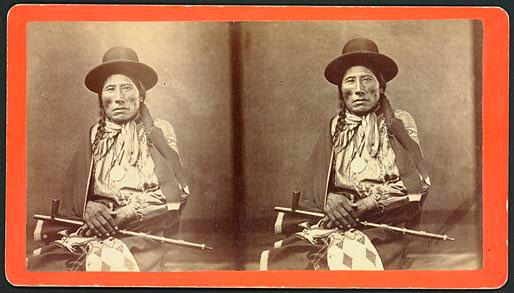 Iron Crow aka Jumping Shield, Oglala |
|
|
|
Post by kingsleybray on Jan 26, 2009 16:47:57 GMT -5
Iron Crow's other name, Dietmar, was Jumping Shield (not Thunder). I'll try to pull together some facts and thoughts.
Kingsley
|
|
|
|
Post by jeroen on Sept 6, 2009 13:24:57 GMT -5
great picture of Iron Crow:  |
|
|
|
Post by Dietmar on Sept 6, 2009 16:12:09 GMT -5
Wow!
Jeroen, again an excellent photo from you. Thanks for sharing!!
I assume Iron Crow is wearing the same medal as in the Mitchell photo.
|
|
|
|
Post by jeroen on Oct 13, 2010 3:08:05 GMT -5
Another Iron Crow portrait:  |
|
|
|
Post by Dietmar on Oct 14, 2010 4:51:59 GMT -5
...identified at Ebay as Little Raven, but it´s Iron Crow: 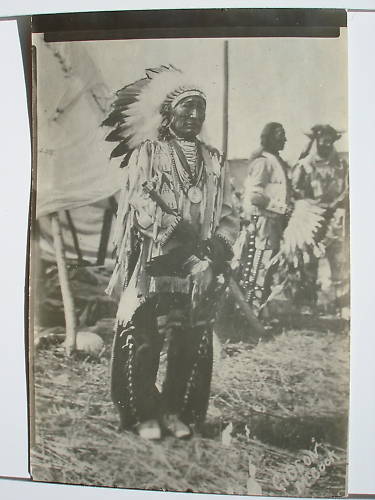 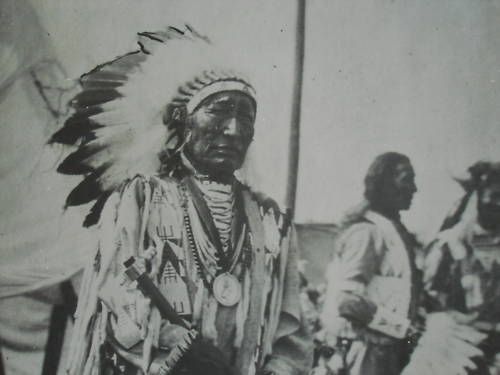 |
|
|
|
Post by jeroen on Oct 19, 2010 8:20:33 GMT -5
Said to be White Calf and Iron Crow:  |
|
|
|
Post by ephriam on Mar 3, 2014 12:54:51 GMT -5
William Iron Crow Kangi Maza (c1850-1925) is one of the interesting individuals that I think deserves more attention.
Born about 1849-50 at the head of Hat Creek, William Iron Crow was the son of the Oglala leader Iron Crow. As will be seen in the interview below, he participated in numerous battles as a young man. About 1875, he married Ite Waste win (Good Face), a sister of Iron Hawk.
During the Great Sioux War of 1876-77, he was with the non-treaty bands. While his family was at the Little Big Horn, Iron Crow himself was absent with a war party against the Crows and did not arrive at the battlefield until the day after. He was apparently among those who surrendered with Crazy Horse at the Red Cloud Agency in May 1877. His father was selected as a delegate to Washington, D.C. that fall; D. S. Mitchell photographed him that year and Iron Crow senior was also photographed as part of the delegation.
As the agencies were being moved to the Missouri River, Iron Crow enlisted as an Indian Scout on Oct. 1, 1877 and served to the end of the year. When the northern bands broke away and headed north to Canada, including Iron Crow (senior), Iron Crow the son appears to have remained behind. He served as an Indian scout from Jan. to April 1878 and again from Jan. to Mar. 1879. William Garnett remembered that William Iron Crow "did the interpreting for Lieut. Dodd when the scouts were enlisted and again when they were paid off." In the Iron Crow wintercount, he recorded 1879 as "First winter they lived on Wounded Knee" Creek. There is an Iron Crow listed in the Pine Ridge Agency issue book for 1879-82 period among the southern Oglala; this may be him.
Meanwhile in Canada, his relatives began returning. His father Iron Crow is probably the individual listed in the Sitting Bull Surrender Census (born c1828) and in the Big Road Roster, not the younger Iron Crow as I originally thought. I cannot find the elder Iron Crow in the 1882 transfer list but presumably he returned to Pine Ridge with the other northern Oglala.
William Iron Crow is listed in the Pine Ridge Agency census from 1886 forward. In 1890, he is listed with the Siksicela Band within the White Clay District while his brother, Joseph Fast Horse is in the Wablenica Hoksila band on the upper reaches of Wounded Knee. William joined the first Indian police at Pine Ridge in the fall of 1879 and in 1891, was first sergeant for the Indian Scouts enlisted briefly during the Ghost Dance troubles. Later he served as the clerk for the Indian court and by 1898, he had been appointed as a judge. By 1912, he had been elected president of the Oglala Council, a precursor to the Oglala Sioux Tribal Council, and was engaged in petitioning the government not to open Washabaugh County to white settlers.
Iron Crow had several children, including Her Many Pipes, later known as Cecilia Iron Crow who married Red Bear in 1897; later the wife of Bald Head (same individual with a different name or a different marriage?). Red Tail Feathers, later known as Amelia, married Chief Eagle. Nicholas Iron Crow is also a part of the family, but appears to have been the son of a close relative who was taken in. Nicholas later worked as an assistant at the Oglala Boarding School. Mary Iron Crow died in 1919 and William remarried the following year to Her Red Blanket.
William Iron Crow provided a copy of his wintercount to Clark Wissler in 1902 and was interviewed by Edmond Meany in 1907. He died June 6, 1925.
Interview:
Wounded Knee
Manderson, S.D. 19 July 1907
Joseph Pourier, Interpreter
Iron Crow
Con-xe-Maza
57 years
Ogalala Sioux
Formerly his Ogalala people were called Can-Hi-yan-za "the determined people." The father of chief Little Wound -- Buffalo Bear (Mah-to-Ta-Tonka) -- was then chief.
When two of the old tribe got into a quarrel and threw ashes in each others' faces there was a separation and Ogalala was taken as a name because it means throwing on each other.
Fast Whirlwind was first chief of the Ogalala proper. He was killed by the white people. Because he had killed an ox soldiers came to arrest him and refusing he was killed. This was about 54 years ago.
At a council later Red Cloud proposed war on the white people and they then chose him chief. Red Cloud was about 40 then though Iron Crow is not sure. It was a short time before they killed the soldiers at Phil Kearney. From that on Red Cloud was considered chief by Sioux and white people; from the same band a branch went north under Crazy Horse.
Iron Crow was 12 when he first went on a war party. It was under Chief Iron Crow his father who was a sub chief -- also Young Man Afraid of His Horses and Big Road father of the present chief of that name. It was against the Crows. Five Crows were killed and 8 Sioux were killed.
Iron Crow participated in about 50 battles.
He counted coup seven time; first [about 34 years ago] on a Pawnee who was out hunting and they charged him and Iron Crow hit him first without dispute; second -- on a white man, a member of a party on which they charged, on whom Iron Crow got a hold of him and later the white man was killed, 31 years ago.
He led a war party against the Crows at the age of 24, and another against the Pawnees at the age of 25 and also three other parties.
He was at the camp during the Custer fight but had gone on a war party against the Crows and got to the Custer battle field the day after the fight.
He was chief of police at the agency and could not get away at the time of the battle of Wounded Knee.
He has not been a medicine man but he had an eagle wing whistle with human hair tied on it as a charm. Lately he had medicine given him by others -- roots given him by Little Crow father of Red Shirt.
He fasted on Little Big Horn mountains for two days and nights. At sundown of second day he heard a whistle and saw an eagle which came where he was standing. He had made an offering of tobacco, red flannel and buffalo calf skin and on this offering, the eagle lighted. He had a buffalo robe as covering and a pipe and at noon he lad his pipe on the ground facing the west. Whenever the eagle made a noise he saw smoke coming from the pipe though he had not lighted it. Then suddenly he saw thunder clouds coming and it began to rain and for four yards around him it was perfectly dry though it rained elsewhere. When it cleared he heard a noise of rattling poles of a tipi being taken down and looking up he saw a switch of human hair suspended in the air. From that he took the eagle wing whistle with the human hair. He understood that the eagle told him that that hair was something good.
He concluded that these things would bring him good luck and that he would be victorious in battle.
|
|
|
|
Post by grahamew on Mar 3, 2014 14:02:28 GMT -5
The reference to a Little Crow being the father of Red Shirt is interesting...
|
|
|
|
Post by carlo on Mar 3, 2014 16:54:08 GMT -5
Great stuff again, Ephriam!
The war party Iron Crow refers to when he was 12 is almost certainly the first Battle of Arrow Creek, a large-scale fight also known as the "Battle Defending the Tipis" (Lakota) or "Where the Camp was Fortified" (Crow), in June 1863. Young Man Afraid took part, as well as many other prominent Lakotas (including Crazy Horse), and eight Lakotas were killed in the affair, as Iron Crow confirms.
It's also interesting to learn that Iron Crow was away on a war party when Custer attacked at the LBH. There is evidence that more of these war parties were sent out against the Crows in the days leading up to the Custer battle, evidence that the Lakotas and Cheyennes were quite confident that the soldiers posed no immediate threat, or that they were secure in their numbers. I'm sure the raids on the Crows were initiated with retaliation in mind for the recent battle with them (and Crook) at the Rosebud...
|
|
|
|
Post by ephriam on Mar 3, 2014 18:41:39 GMT -5
Carlo, I agree that the battle he is referring to is the first Arrow Creek fight.
Upon further reflection, I made a small change to my brief biography of William Iron Crow. It occurred to me that in 1877, he would have only been about twenty-eight years old, too young to be the Iron Crow shown in the D.S. Mitchell portrait or in the Mathew Brady photographs of the delegation to Washington, D.C. He would also have been too young to have had a major leadership role yet.
Assuming that the Iron Crow recorded in the Sitting Bull Surrender Census (Family 517, p. 137) is the father, born about 1828, this would make him about 49 or 50 in 1877, much more in keeping with these 1877 photographs. This would suggest that the 1877 portraits are of the elder Iron Crow, and that the name Jumping Shield probably applies to him as well. I will have to do some more digging to see what I can find out about the father.
|
|
|
|
Post by carlo on Mar 4, 2014 6:19:09 GMT -5
Yes, it makes sense that this man was Iron Crow Sr.
I personally believe that Iron Crow Sr. was also known as Jumping Shield, and not his son. I wouldn't be surprised if Iron Crow Sr. changed his name to Jumping Shield when his son took over the Iron Crow name. By the turn of the century and later, Anglo historians may well have confused the two men and put the alternative name Jumping Shield on Iron Crow Jr. as well. Just a theory of course, but I doubt father and son carried both the Iron Crow AND Jumping Shield names.
Carlo
|
|
|
|
Post by Dietmar on Mar 9, 2014 7:01:19 GMT -5
The elder Iron Crow in 1877 as part of the Sioux delegation in Washington: 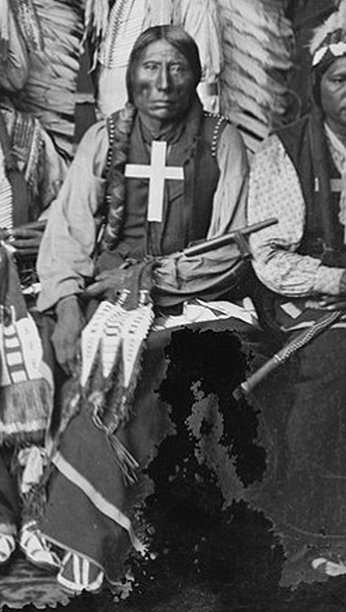 ...and here´s a portrait of Iron Crow from the Smithsonian´s archive:  "Iron Crow (Kaughi Maza)" Copyright 26 DEC 1907 by Edward S. Curtis |
|
|
|
Post by Dietmar on Mar 9, 2014 9:05:08 GMT -5
A better resolution version of a picture Jeroen has posted: 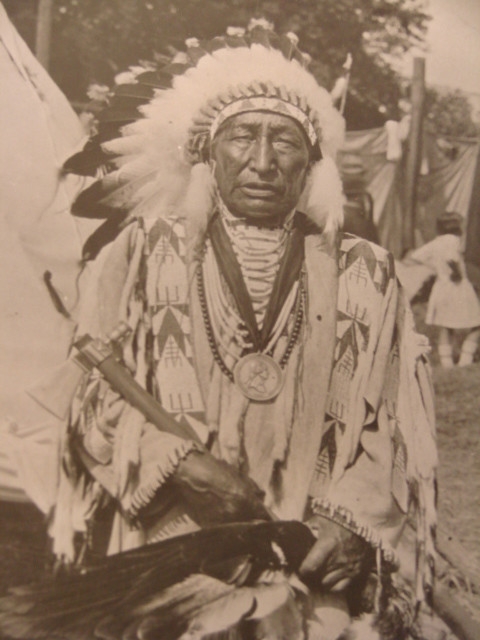 Can anyone identify from what period the medal he wears is? Must be an old one... and I guess the elder Iron Crow wears the same medal in the Mitchell picture of 1877. |
|
|
|
Post by Dietmar on Mar 9, 2014 9:21:10 GMT -5
George Washington, 1789 ??
|
|